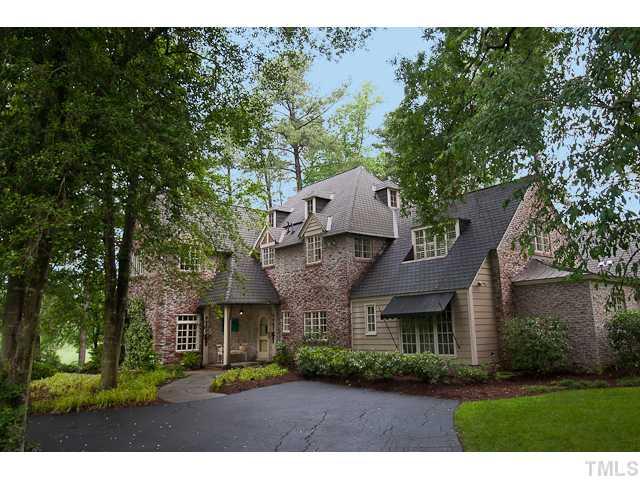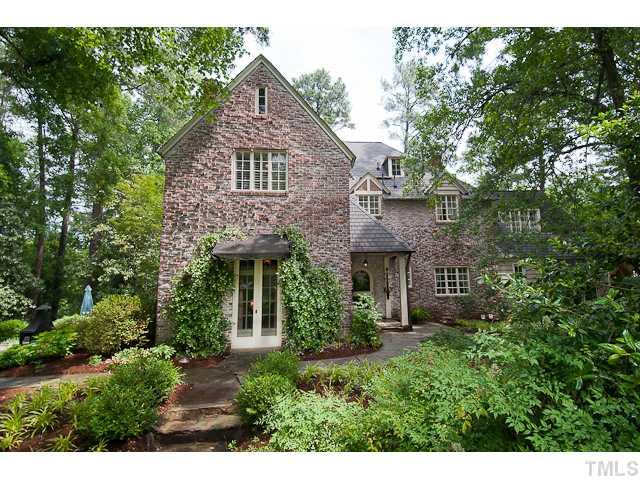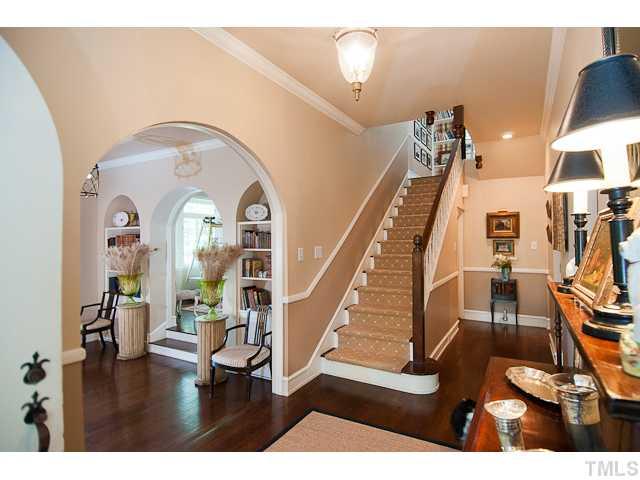From the 2002 Preservation Durham home tour booklet:
Having arrived at Duke in 1925, Professor Harvie Branscomb and his wife, Margaret, bought this delightful and richly-detailed Tudor Revival house on Chelsea Circle two years later. The Mebane & Sharpe Company had built the house as one of a handful of "seed" houses intended to attract people to the new development; the Branscomb House is one of the very first built and occupied in Hope Valley.
While at Duke, Dr. Branscomb served briefly as Director of Libraries and ultimately as Dean of the Divinity School. He left Duke in 1946 to become Chancellor of Vanderbilt University, where he served until 1963. In his retirement as Chancellor Emeritus, Branscomb continued to distinguish himself as a major figure on the national and international education scene until his death in 1998 at the age of 103.
Noted Durham architect George Watts Carr designed the house, and although it has been enlarged several times during its 75-year history, the essence of the house that Carr originally conceived has survived intact. Before entering the house, examine its exterior, which possesses the defining features of the Tudor Revival style. The steep, irregular roof, massive molded chimney, gerkin-headed gables, and asymmetrical plan are all meant to suggest the randomness of medieval buildings. Notice the random way the masons laid the brick. This, too, is intended to give the house an antique appearance. Approaching the front entrance, note the three dormer gables. While two are clad in clapboard, the one over the door is nogged with brick in a herringbone pattern. Examine the eave detail and you may see the cedar shakes of the original roof peeking out from beneath the modern shingles.
The entry porch covering the front door is supported by carved beams roughly·cut to give the appearance of being hand-hewn. Once inside, observe the layout of the original portion of the house, as its footprint is similar to that of the D. T. Smith House which is also on the tour. On the right is a small study, a relatively new feature in American residential design. On the left, a broad archway invites you down into a sunken living room. Passing beneath the arch, notice the absence of molding. Originally, the house had very little in the way of molded woodwork. The interior doors are not paneled, but made up of vertical boards in medieval fashion.
The living room itself is spacious and well lit by the original casement windows-another feature of the Tudor revival style. Above your head are more rough-carved beams. At the end of the living room, another arch invites you into an ample dining room with a bright bay window. You now leave the original structure and enter new spaces thoughtfully added to the house. An exterior porch is now a den with a new, dry-laid fireplace. The small original kitchen has been enlarged and appointed with gleaming granite and stainless steel appliances. The original two-bay garage became a new master bedroom and a new garage contained within an addi- tion is so carefully joined to the house that it is almost unnoticeable from the street. The present owners, Lynn and Jerome Anderson, insisted that the new brickwork match the masonry of the original house and that the new garage doors mimic the swing-out originals, with iron strapwork and false handles.
The second floor originally contained four bedrooms and two baths. Over time, however, successive owners have considerably remodeled these spaces to accommo- date modern living. Still apparent, though, are the deep-set casement windows with- in solid masonry walls, the slanted three-quarter ceilings, and the Jacobean bun- shaped finials on the stair newels. Unexpectedly, the stair continues beyond the sec- ond story to a tiny maid's apartment in the attic. The bedroom and bath here are still very much in their original condition. Notice the twenties era sand-finished plaster walls that used to be found throughout the house. Also of note are the five-paneled doors, commonly found in bungalows of the period, which were reserved for the ser- vant's area of the house.
The Branscomb house is an important artifact in Durham's architectural and urban history. We are fortunate that the house has always been in the hands of own- ers sensitive to its historical significance and Tudor Revival style.




Add new comment
Log in or register to post comments.